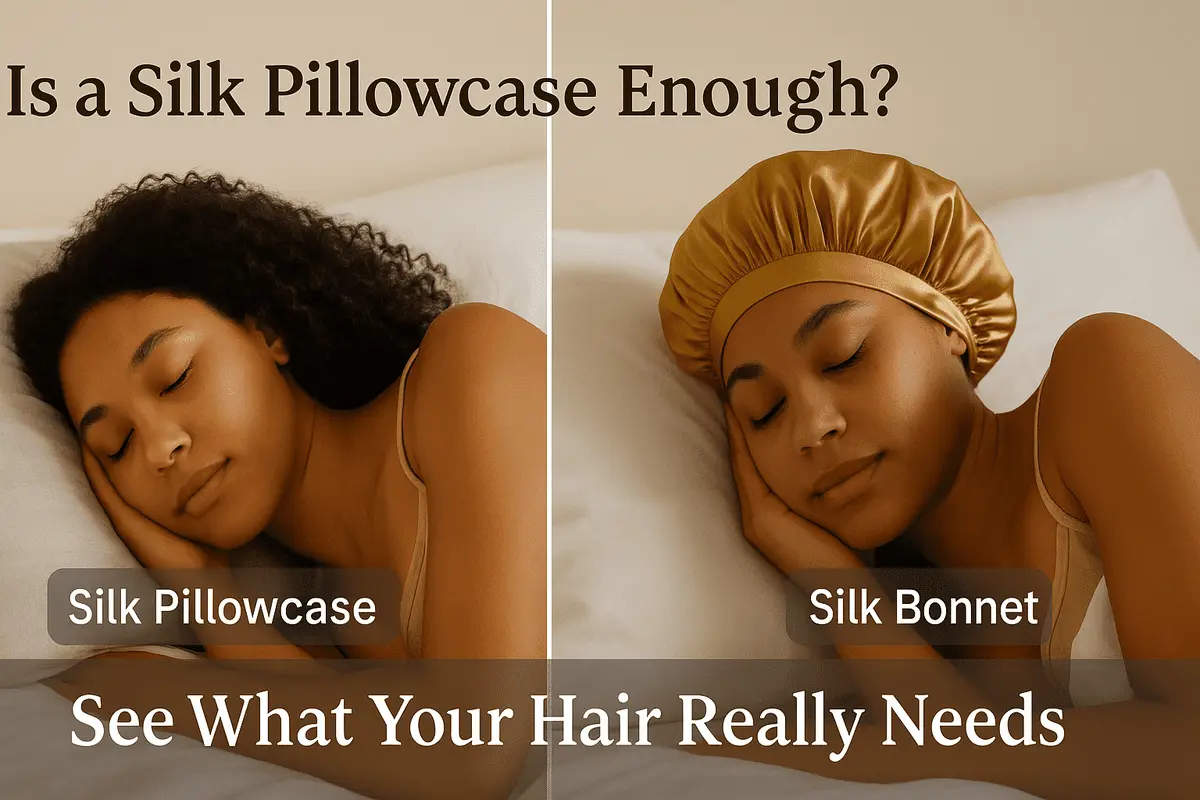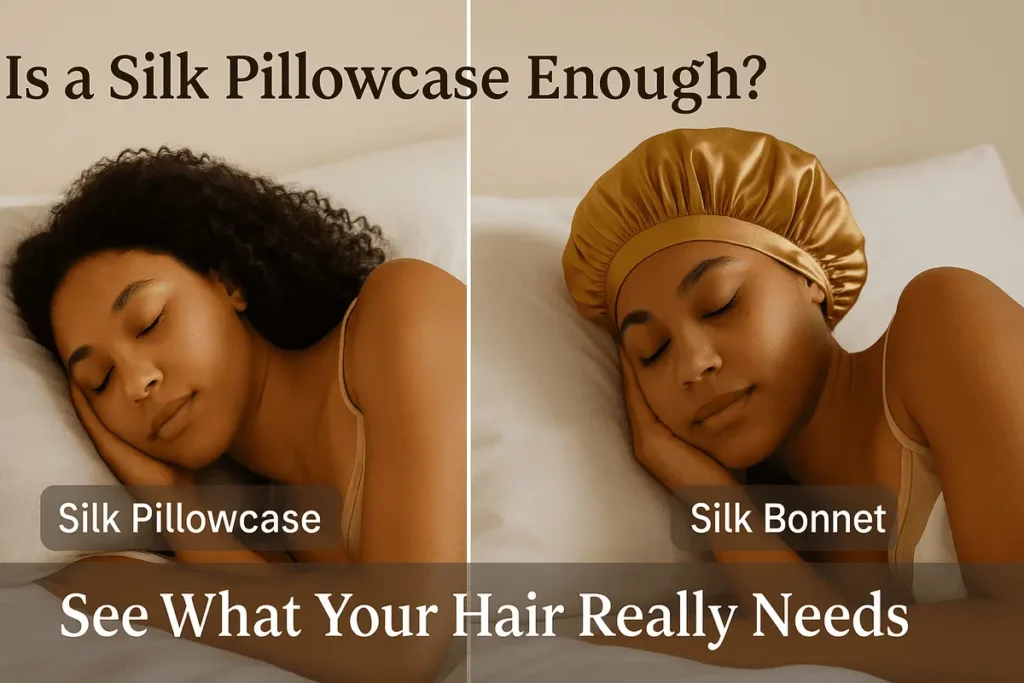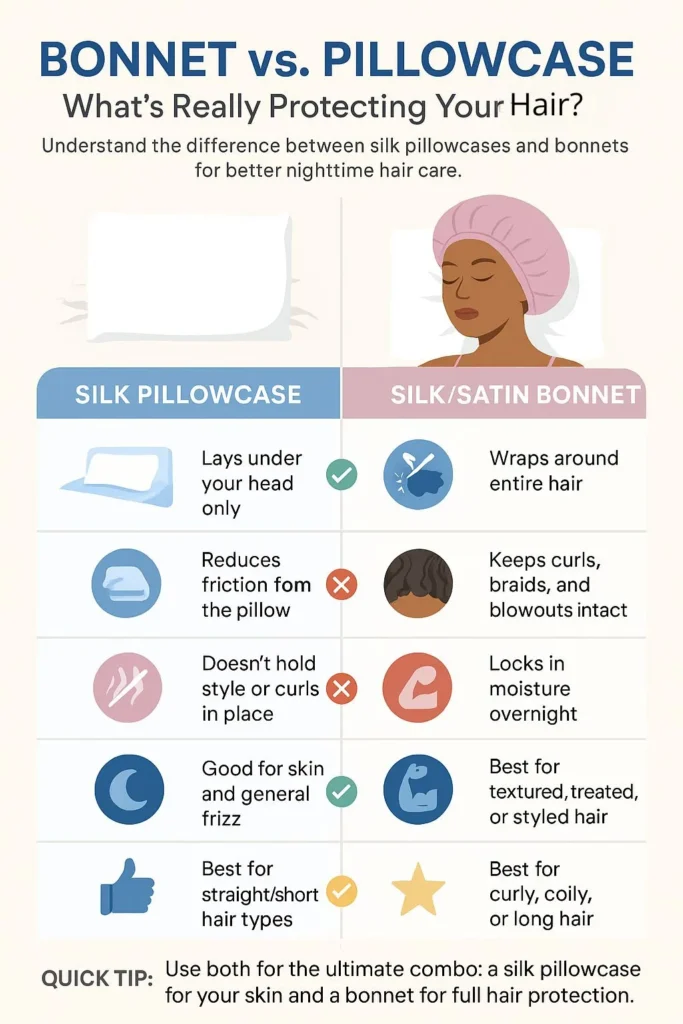🧠 Introduction: The Overnight Haircare Dilemma
You bought a silk pillowcase to protect your hair while you sleep. It’s soft, luxurious, and promises to fight frizz. But despite the switch, your hair still wakes up dry, tangled, or flat. Now you’re wondering—do you also need to wear a bonnet?
It’s a common question, especially if you have curly, coily, or textured hair. Silk pillowcases and bonnets are both praised for reducing breakage, keeping hair moisturized, and extending styles. But do you really need both?
In this guide, we’ll break down what each one does, when a bonnet makes a difference, and whether combining the two is worth it. By the end, you’ll know exactly what’s right for your hair—and your sleep routine.
🪄 What Does a Silk Pillowcase Actually Do?
Silk pillowcases are a beauty favorite—and for good reason. Unlike cotton, silk creates less friction while you sleep. That means fewer tangles, less frizz, and reduced hair breakage overnight.
They also help your hair retain moisture. Cotton tends to absorb natural oils and hair products, which can dry out your strands. Silk, on the other hand, allows your hair to keep more of its natural hydration.
And it’s not just good for your hair. Silk pillowcases are also gentle on the skin. They reduce sleep lines, don’t pull on delicate areas like the under-eyes, and are often recommended for acne-prone skin.
But while silk pillowcases provide a great foundation for healthier hair and skin, they don’t always keep hair in place—especially if you move around a lot at night.
👑 What Does a Bonnet Do That a Pillowcase Doesn’t?
A silk or satin bonnet offers something a pillowcase can’t: full hair coverage and containment.
While a silk pillowcase reduces friction between your hair and the surface of the pillow, it doesn’t stop your hair from rubbing against itself—or from getting flattened, tangled, or stretched while you sleep. A bonnet wraps around your entire head, keeping your hair in place and protecting it from nighttime movement.
Bonnets are especially useful for:
- Curly, coily, or natural hair, which is more prone to frizz and breakage
- Protective styles like braids, twists, and blowouts
- Hair that’s been treated with oils, creams, or leave-ins—keeping product on your hair, not your pillow
In short, a bonnet acts like a gentle shield. It helps preserve your hairstyle, locks in moisture, and prevents friction from all angles—not just between your head and the pillow.
⚔️ Silk Pillowcase vs Bonnet: Which Should You Use?
The choice between a silk pillowcase and a bonnet depends on your hair type, sleep habits, and overall goals. Both offer protection—but they do it in different ways.
🛏️ When a Silk Pillowcase Might Be Enough:
- You have straight, short, or fine hair that doesn’t tangle easily.
- You don’t move much while sleeping.
- You prefer not to wear anything on your head at night.
- You’re more focused on skin benefits—like reduced breakouts or fewer wrinkles.
A silk pillowcase gives your hair a smooth, low-friction surface to rest on. It’s a great option if you’re looking for a low-maintenance solution.
🧢 When You’ll Benefit from Adding a Bonnet:
- You have curly, coily, or textured hair that needs extra moisture and definition.
- You wear protective styles (like braids or twist-outs) you want to preserve.
- You apply leave-ins, oils, or creams before bed and want them to stay on your hair—not soak into your pillow.
- You toss and turn while sleeping, which causes your hair to rub, tangle, or frizz.
For many people, using both—a silk pillowcase and a bonnet—offers the best of both worlds: all-over protection for your hair and bonus skincare benefits for your face.
💬 What Hairstylists and Trichologists Say
Hair experts agree: both silk pillowcases and bonnets have value—but your hair type and nighttime routine make the biggest difference.
According to trichologist Dr. Kari Williams, “High-porosity hair absorbs excess humidity, which raises the cuticle and leads to frizz. The right accessories can minimize this damage by reducing friction and maintaining curl shape.” That means bonnets can play a key role in preventing breakage for those with textured or chemically treated hair.
Many professional hairstylists also recommend bonnets for anyone with curls, coils, or protective styles. These hair types are more vulnerable to overnight manipulation, so a bonnet helps keep them defined and moisturized longer.
On the other hand, silk pillowcases are often recommended for clients who:
- Prefer a simpler routine,
- Don’t like the feeling of something on their head, or
- Want added skin benefits alongside hair protection.
The takeaway? For smoother, healthier hair—especially if it’s dry, fragile, or high-maintenance—stylists often suggest pairing both.
🛌 Real-Life Experiences: What People Say
Sometimes, the best advice comes from people who’ve been there. Online forums like Reddit and TikTok are full of personal stories from users trying to figure out if a bonnet is really necessary with a silk pillowcase.
Here’s what some shared:
“I thought a silk pillowcase would be enough, but my curls were still dry in the morning. Adding a bonnet made a huge difference.”
– r/CurlyHair user
“I use both. The pillowcase helps my skin, and the bonnet keeps my twist-out intact overnight.”
– TikTok creator @curlsbykai
“The bonnet kept my braids from rubbing all over my face, and I didn’t wake up with frizz for once.”
– r/NaturalHair community member
Many users say they started with just a pillowcase, then added a bonnet when they noticed their hair still lacked moisture or shape. Others say they only use a bonnet when wearing specific styles, like silk presses or braids.
Overall, combining both tools often delivers the best results—especially for those with high-maintenance hair or active sleep habits.
Easy Curly Hair Accessories for Wedding Guests: Frizz-Proof & Budget Picks (2025)
🛍️ What to Look for When Choosing a Bonnet or Pillowcase
Not all silk products are created equal. Whether you’re buying a pillowcase, a bonnet, or both, the right materials and features make a big difference in how well they protect your hair.
✔️ For Pillowcases:
- 100% Mulberry Silk—The highest quality silk, known for being ultra-smooth and durable.
- Momme Weight (19–25 momme) – This measures silk density. Higher momme = more durability and shine.
- OEKO-TEX Certified – Guarantees that the fabric is free of harmful chemicals.
- Envelope or Zipper Closure—Helps keep the case in place overnight.
✔️ For Bonnets:
- 100% Silk or High-Quality Satin—Avoid polyester satin that can trap heat or cause buildup.
- Adjustable Fit—Look for bonnets with a drawstring, elastic band, or tie closure for comfort and security.
- Double-Layered Design—Better for moisture retention and durability.
- Stay-Put Grip—If you’re an active sleeper, consider bonnets with a wide band or “non-slip” interior.
⚠️ What to Avoid:
- Rough or low-grade satin that can snag or dry out hair.
- Pillowcases labeled “silky” that are actually polyester blends.
- Bonnets that slip off easily or have exposed elastic that digs into your skin.
Pro Tip: If your goal is maximum protection, pairing a silk bonnet with a silk pillowcase ensures backup coverage if one shifts during sleep.
📌 TL;DR: Quick Answer Based on Your Hair Type
Still unsure whether you need both a bonnet and a silk pillowcase? Here’s a quick cheat sheet based on your hair type and overnight needs.
🧾 Summary Table
| Wants skin and hair benefits | Just Pillowcase ✅ | Pillowcase + Bonnet ✅✅✅ |
|---|---|---|
| Straight, short, or fine hair | ✅ Good enough | ❌ Often unnecessary |
| Curly or coily hair | ❌ Not enough | ✅✅✅ Highly recommended |
| Long or thick hair | 🔄 Some benefit | ✅ Better moisture + control |
| Braids, silk presses, twist-outs | ❌ Not protective | ✅✅✅ Style preservation |
| Uses heavy products overnight | ❌ Product absorbs | ✅ Prevents transfer |
| Moves a lot in sleep | 🔄 Limited help | ✅✅ Secures hair in place |
| ✅ Better moisture and control | ✅ Great for skin | ✅ Even better together |
✅ Final Word:
If your hair is delicate, curly, or styled, using both a bonnet and a silk pillowcase offers the best all-around protection. But if you’re looking for something simple and mostly focused on skin or mild frizz control, a high-quality silk pillowcase alone might be enough.
❓ Frequently Asked Questions (FAQ)
Q: Can I just sleep on a silk pillowcase without wrapping my hair?
A: Yes, but it depends on your hair type. A silk pillowcase reduces friction and is helpful for straight or short hair. However, for curly or styled hair, you may still experience frizz or moisture loss without a bonnet.
Q: What’s better for curls—a silk bonnet or a silk pillowcase?
A: A silk bonnet offers better protection for curls. It keeps them contained, defined, and moisturized overnight. A silk pillowcase is a great backup, but on its own, it won’t preserve curl shape as well.
Q: Do I need a bonnet if I sleep on my back and don’t move much?
A: If you rarely toss and turn, you might get by with just a silk pillowcase—especially if your hair is short or low-maintenance. But if you have longer or textured hair, a bonnet still adds valuable protection.
Q: Is a satin bonnet just as good as a silk bonnet?
A: Satin bonnets can work well, especially if they’re made from high-quality synthetic satin. However, 100% silk is more breathable, natural, and less likely to cause buildup or scalp irritation.
Q: Will sleeping with a bonnet flatten my curls or make them lose volume?
A: Not if the bonnet is the right size and shape. A loose-fitting, double-layered bonnet allows your curls to rest without being squished. Look for options designed specifically for natural hair or voluminous styles.
✅ Final Verdict: Our Recommendation
So—do you need a bonnet if you already have silk pillowcases?
If your hair is curly, coily, chemically treated, or prone to dryness, then yes, a silk or satin bonnet is still worth using. It offers full coverage, locks in moisture, and helps preserve your style—something a pillowcase alone can’t guarantee.
But if you have short, straight, or low-maintenance hair, and you’re mainly looking for general frizz control or skin benefits, then a high-quality silk pillowcase may be enough on its own.
For many people, using both gives the best results:
- The pillowcase protects your skin and reduces overall friction.
- The bonnet keeps your hair contained, styled, and moisturized.
🛍️ Want to Try It?
Start with one. If you’re already using a pillowcase and still waking up with frizz, dryness, or flat curls—add a bonnet and see the difference. Many find it’s a small change that delivers big results.
Check out our favorite silk bonnets and pillowcases that actually stay in place


